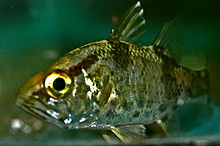Apogoninae
| Apogoninae | ||||||||||||
|---|---|---|---|---|---|---|---|---|---|---|---|---|

Red mullet kings ( Apogon imberbis ) |
||||||||||||
| Systematics | ||||||||||||
|
||||||||||||
| Scientific name | ||||||||||||
| Apogoninae | ||||||||||||
| Günther , 1859 |
The Apogoninae are the most species-rich and most diverse subfamily of the cardinalfish (Apogonidae) in terms of shape, size, color and habitat . It occurs close to the coast in tropical and subtropical regions of the Indo-Pacific , Eastern Pacific and Atlantic, down to depths of 300 meters.
features
In their current composition, the Apogoninae are based on molecular biological investigations and for the subfamily not a single synapomorphism can be given, which occurs in all species of the subfamily. Many species have a narrow supramaxillary (a jawbone), whereas the species of the subfamily Amioidinae are large. Other Apogoninae species, however, lack the supramaxillary as well as the species of the subfamilies Paxtoninae and Pseudaminae . The basic phenoid (sphenoid bone) is reduced or completely absent. The ridge as well as the edges of the preoperculum are smooth or serrated, its lower part may not be ossified.
The scales can be round or comb scales or prickly or may be absent. The base of the second dorsal fin can be surrounded by scales. A lateral line is present and extends from the posterior temporal bone (post-temporal) to the base of the caudal fin. It is either accompanied by scales with one or two pores or only indented scales, but it can also be scaly with free neuromasts. A second sideline on the lower half of the body may be present or absent. On the head, the sensory system is complex with numerous pores and grooves.
The ribs from the third to the tenth vertebra are rod-like or proximal (towards the center of the body). The anterior uroneural pair is absent in the caudal fin skeleton , while the posterior pair is reduced or absent. The number of epuralia (elongated, free-standing bones) is 0 to 3. The hypuralia 1 to 5 are present. Hypuralia 5 is always free, the others are free or have grown together in various combinations. The parhypuralia are free or have grown together with the hypuralia 1 and 2.
The Apogoninae are the only subfamily with bioluminescent species (genus Siphamia ).
- Fin formula : dorsal 1 VI – VIII, dorsal 2 I / 9–13; Anals II / 8–18, pectorals 11–16, caudals 9 + 8.
- Scale formula : SL 3–48.
- Gill rake : 10–26.
- Vertebrae 9-10 + 14-16.
- Ribs 8.
- Epineuralia ("upper bones") 8.
Internal system
The Apogoninae are divided into 14 tribes and 34 genera. The following cladogram shows the relationships between the subfamilies and the tribe:
| Apogonidae |
|
|||||||||||||||||||||||||||||||||||||||||||||||||||
|
|
literature
- K. Mabuchi, TH Fraser, H. Song, Y. Azuma, M. Nishida: Revision of the systematics of the cardinalfishes (Percomorpha: Apogonidae) based on molecular analyzes and comparative reevaluation of morphological characters . In: Zootaxa . 3846 (2), 2014, pp. 151-203. doi: 10.11646 / zootaxa.3846.2.1
Web links
- Apogoninae on Fishbase.org (English)



